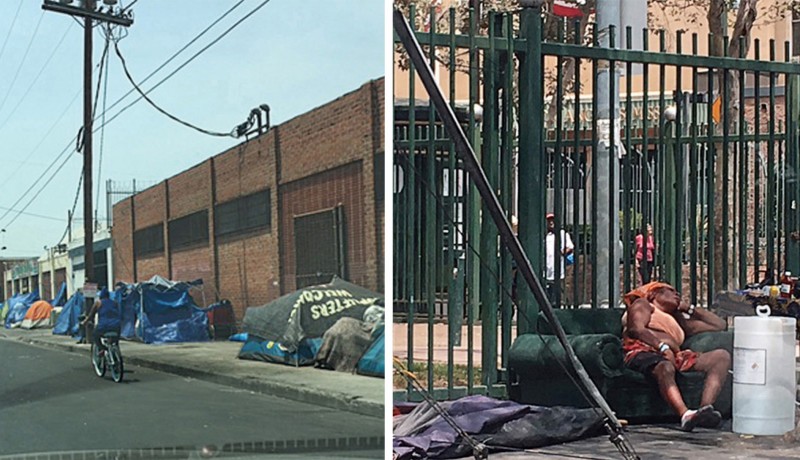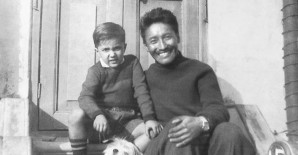
Columns

Homeless in the City of Dreams, some silvers turn entrepreneurs, others altruistic, writes Kamla Mankekar
Most evenings she would be sitting there, resting her back against the wall of one of the student housing buildings on Gayley Avenue, her legs stretching out and a beat-up shopping cart with her worldly possessions piled up neatly, parked by her side. She is one of the many thousands of homeless on the streets of Los Angeles (LA).
While out on my evening walk, I would sometimes stop by to drop a few coins on her plate. She would acknowledge it with a nod and a smile. Light-skinned, with big luminous eyes, her patched dress washed clean and her hair piled high in a bun, she looked somewhat different from the common run of the homeless. Once, when I tried to talk with her she told me she was 68 years old and her name was Angela; beyond that she would not reveal.
A couple of weeks later when I stopped at a café after my grocery shopping, the lady on the table next to mine nodded at me with a friendly smile; she looked familiar but I could not place her. She was dressed in a black gown and a matching hat, and had a magazine in her hand; she finished her coffee, dusted some cake crumbs off her lap and got ready to leave. And then I saw the shopping cart parked next to her chair. “Oh my God,” I exclaimed! She looked at me, amused, and wheeled away her cart. That was Angela.
Ben, who occupies a bench near University of California – Los Angeles (UCLA) Medical Plaza is different; he looks every inch a man living on the street. Chased away from his roadside perch by police during the day, he ventures to rummage trash bins outside restaurants and bakeries. University students, perhaps collecting data on the city’s poor or out of curiosity, sometimes stop by to talk with him and give him a few coins. Ben is 72 and has been on the streets for well over a decade-and-a-half. Unwashed, smelly, wrapped in a tattered coat even under the midday sun, his baggage bundled in plastic wraps held under his arm, he clutches a soiled blanket that protects him from the night chill. He returns to the bench at night to sleep.
As per city rules, while the homeless are not allowed to occupy pavements and public places during the day, they may pitch their tents on sidewalks or sleep undisturbed on roadside benches at night.
Annie of Skid Row is an entrepreneur in her own right. Her bobbed hair dyed jet black is a contrast to her ageing face. A folding chair, a set of scissors and combs and a hand mirror are the tools of her trade; she is a hairdresser for the street dwellers of Skid Row in downtown LA.
Skid Row, however, is different; it is a world by itself. Stretched across three major streets that cover an area of a few kilometres, Skid Row is home to thousands of men and women, old and not so old, who live on its pavements. Adjoining the city’s fashion district and a flourishing business hub with jewellery shops, hotels, banks and corporate offices, it is home to the largest congregation of homeless in the country. Back walls of luxury apartments loom large over its streets, which become a city of tents by night. As the day breaks and the police start their rounds, the tents are folded and along with bundles of clothing, sleeping bags, mugs and plates, mattresses and blankets are stacked on sidewalks and the occupants move away to roam the streets. They hobble on canes, push walkers; some even are on wheelchairs. They sit outside restaurants, hoping to get some leftover food or rummage trash bins to pick up what is tossed in there. Some have been without a home for a generation. Dispossessed, sick, lonely, scared of their future, they strive to ward off hunger and disease.
Skid Row is riddled with crime; petty thefts, sex and drugs often result in bloody fights. Yet it is a community to which the Skid Row dwellers cling. They feel a sense of belonging here. Mariam, 70 and on a wheelchair, goes to the soup kitchen run by a charity group that doles out food three days a week, with a plastic bag to collect some extra bread and beans. She brings it to those who are too frail or sick to stand in line for the dole. Jeff, at 76, is like a community doctor; he distributes painkillers for the arthritic and cough syrup when flu sweeps the tents. Lucia, still strong at 64, watches over her friend’s belongings when the latter goes in search of her runaway poodle.
The civic authorities have set up night shelters, which though inadequate for the growing numbers of homeless in greater Los Angeles, provide certain basic amenities.
The street dwellers, however, shun these places. “Those dumps,” Angela had said with disgust, “full of disease and dirt! Not for me.”
Skid Row is not the only area inhabited by the homeless silvers of LA. They are seen practically everywhere—under the flyover bridges, along parks, in Hollywood and around fashionable and rich Santa Monica and Venice counties. They are of various ethnicities—Jews, Greeks, Italians, Latinos, African Americans and White Americans—and come from different backgrounds. Some are victims of the recession of the 70s; some lost jobs following long periods of sickness; drugs and alcoholism, too, add their share of victims to the growing numbers on the streets. A couple of years back, a hospital was found dumping on Skid Row patients who had no homes to go back to.
Once on the streets, it is almost impossible for silvers to get back into mainstream life, to secure a job, a place to live and financial stability. Even voluntary agencies which strive to rehabilitate the homeless prefer to use their resources on the younger lot.
The majority of silver women rendered homeless happen to be either divorcees or those who left homes and families to escape domestic violence. Emmy is one of them. For years, she suffered an alcoholic husband who beat her relentlessly. But, she said, she did not have the heart to abandon her two daughters. “Now they are in their teens and can you believe it, they blame me for all those fights! I could not take it anymore,” she told me. Her family does not know her whereabouts and she has no intention of going back.
The emergence of growing numbers of ageing homeless is a challenge for rehabilitation agencies. The government is well aware of the problem but has its own priorities, including finding homes for war veterans.
The silvers, meanwhile, have little else than one another to fall back on. A family away from home.
Mankekar is the author of Breaking News: A Woman in a Man’s World, which chronicles her experiences as a pioneering woman journalist in India
Photo: Kamla Mankekar Featured in Harmony — Celebrate Age Magazine April 2017
you may also like to read
-
Mental workout
Mukul Sharma tells you how to keep those grey cells ticking Everyone will ultimately lose his or her brain….
-
Helpline
Dr Harshbir Rana answers your queries on personal and social issues related to ageing, elder care and intergenerational relationships ….
-
Off the cuff
Raju Mukherji pays tribute to his first hero, Tenzing Norgay, an exemplary mountaineer Darjeeling, 1955. Dr ‘Pahari’ Guha Mazumdar….
-
Yoga RX
Shameem Akthar shows ways to control debilitating ankle pain through regular practice Ankle pain is so common and prevalent….







